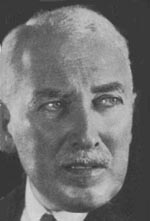Sinological Profiles
Erich Haenisch
27 August 1880 (Berlin) - 1966
Haenisch was the architect German Sinology never had. He was primarily a Mongolist, but impinged on Sinology as well, usually to its benefit.
His family background was official and military. He studied Sinology, Mongol, and Manchu under Wilhelm Grube at Berlin. Haenisch was himself a Berliner, and Berlin was to remain the center of his career. From it he made four significant departures. The first was immediate: after his studies with Grube, he went to China to teach at military schools in Wuchang and Changsha from 1904 to 1911. During this time he also traveled in China and in Eastern Tibet. In 1912 he returned to Germany and joined the Berlin Museum für Völkerkunde. In 1913 he completed his Habilitation and became an assistant to F W Müller. Another military interlude followed, as an officer during WW1. In 1920 he made a handsome return to civilian life as Professor of Mongol and Manchu at Berlin.
In 1925 he moved to the Chair of Sinology at Leipzig, in succession to Conrady, and his publications take for a while a Sinological turn, starting with an article on Some Sinological Desiderata (1926): taking stock of the field and setting priorities. Due to Haenisch's protracted absence from Leipzig while traveling in China and Mongolia, the Conrady student Eduard Erkes was appointed in 1928 to fill in for him as an Ausserordentlicher Professor. The three volumes of Haenisch's Lehrgang der Chinesischen Schriftsprache appeared over the years 1929-1933. It must be said that this is not the wonderful thing it is sometimes said to be. Presumably it was an improvement over whatever people had been doing previously. All the more credit, then, (let it be said in a parenthesis) to those of the pioneering generation who achieved a sometimes staggering competence in the language.
Haenisch returned to Berlin in 1932, with a renewed emphasis on things Inner Asian. A first instalment of his translation of the Secret History of the Mongols had been published in 1931, and further instalments appeared in 1937 and 1939. It has been judged by those who know that it is superior to the never-published version - the Secret Translation of the Secret History - by the indomitable but procrastinating Pelliot. Haenish picked up the retired Franke's student George Kennedy, and supervised Kennedy's thesis, which was on a legal topic, and based on the Tang Code. He also put in a word at Berlin for a Sinological resource which had been formally banned by Pelliot in 1929: the fractious von Zach. Looking back on that interlude, Haenisch put it this way:
Of course one could not mention his name in De Groot's presence. When I once dared to break a lance for him, he came straight back at me, "Do you want Sinology in Berlin to be built, or demolished?" Well, naturally, built, but Zach ought to help with the building. This positive contribution he himself unfortunately denied us, by the often intemperate tone of his criticisms.
Haenisch, a decent man as well as a careful scholar, had protested German treatment of Duyvendak in the occupied Netherlands, and distinguished himself in 1944 as the only German Sinologist to sign a petition for the release of Henri Maspero, then a prisoner at Buchenwald. There had been more international spirit, and it had had better success, in the case of Henri Pirenne in WW1, who as a result of international and German scholarly pressure was released from a prison camp in Belgium and transferred to the house arrest situation in rural Germany, where, partly out of his head, he was able to put down what became his masterpiece: the Histoire de l'Europe. Had the world received a similar final synthesis from Maspero, Haenisch would have deserved mention on the dedication page. It was not to be.
Germany had been hard on Sinology before and during WW2, driving many of the most promising people out of the country. And WW2 had been hard on Germany. Haenisch was one of those left to become the statesmen of the Sinological building effort after 1945. Of the prewar centers that still existed (among them Heidelberg, Göttingen, Hamburg), Berlin was a divided city, and Leipzig had come under Soviet domination. Haenisch, making his fourth and final excursus from Berlin, founded in 1946 the Sinological Section of the Institute of East Asian Studies at Munich, the first such center to be created in postwar Germany. Conditions were not ideal:
In summer, we sometimes held classes in corridors and sometimes in wooden shacks; in winter, we held them in the department's only undamaged building. Eventually we got a building of our own which served as library, classroom and office.
A special issue of Asia Major was dedicated to Haenisch on the occasion of his 70th birthday in 1950. He remained as Professor in Munich until his retirement in 1952. In that year, the civilian or Arts and Sciences version of Germany's highest decoration, the Pour le Mérite, was revived after a lapse of 20 years, and Haenisch (officially listed as living in Herrenchiemsee) was one of the recipients: the only "Sinologue," save for Bernhard Karlgren a bit later, in 1955, ever to be so honored.
An 80th birthday Festschrift, Studia Sino-Altaica, was published by Steiner in 1961. Haenisch died in 1966, but not without a final symbolic return: he had bequeathed his collection of 4,500 Manchu and Chinese books to the Staatsbibliothek in Berlin, where they are still available to researchers.
E Bruce Brooks
References
- Lebenslauf. MS v5 (1940) 1-5. Preface to an issue dedicated to Haenisch on his 60th birthday; includes a list of publications through 1939.
9 June 2004 / Contact The Project / Exit to Sinology Page

